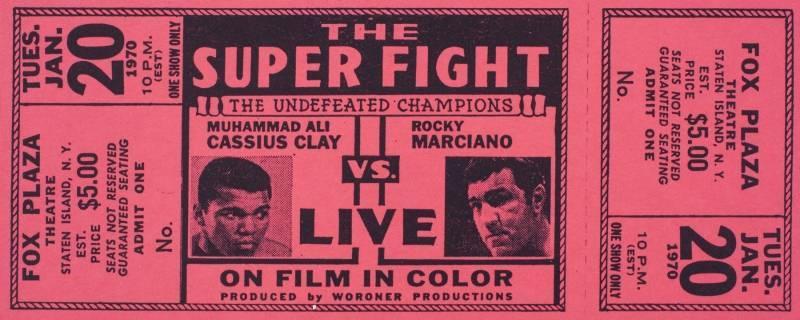The Muhammad Ali vs. Rocky Marciano boxing match was screened in theatres across Europe and North America in 1970. In American theatres, Marciano won. In European theatres, Ali did.

Rocky Marciano was one of the most successful boxers in history. He held the world heavyweight title from 1952 to 1956 and retired without ever having lost a match – the only heavyweight champion to ever do so. Muhammad Ali was one of the most successful boxers in history. He won the world heavyweight title three times and is considered one of the most influential sportspeople of the 20th century; his title bout against George Foreman in 1974 was at that time the most viewed live sporting event in history.
Marciano and Ali never fought a real match against each other – Marciano retired in 1956, and Ali did not become a professional boxer until 1960 – but pretty much everyone with even a passing interest in boxing was interested in what such a match-up would have looked like. And they got their wish… sort of.
In the early 1960s fantasy sports were just taking off. In these hypothetical leagues, people select a roster of current sportspeople (in American football or baseball, for example) and over the course of a season they see how well their fantasy teams would do, based on the real life performance of those players. In 1968 a radio producer named Murray Woroner decided to try something similar with boxing.
This was the set-up: a series of imaginary matches between the most famous heavyweight boxers of history: Gentleman Jim Corbett, Jack Johnson, Marciano, Ali, and a dozen others. Woroner and others gathered a bunch of data – punches, strengths, weaknesses – and ran them through a computer algorithm designed for this purpose. It was all hokum, of course, but the presence of a computer gave it all an air of legitimacy. The output was staged as a radio play, an imaginary blow-by-blow account of these hypothetical fights.
(Side note: the computer was an NCR-315, a real powerhouse of a machine at the time. It weighed 600kg and had a massive 20K of memory. It would take a dozen NCR-315s to store the picture at the top of this post.)
The radio match-ups ended with Marciano’s overall victory; Ali had been knocked out by Jim Jeffries in the second round. Ali (the real one) was furious – at the time his boxing licence had been revoked for his protest against the Vietnam War draft, and this imaginary defeat felt like a serious defamation of character. So he sued Woroner for a million dollars.
The lawsuit never got to court because the two settled on an agreement instead. Woroner would re-do the computations, this time for a fight between Ali and the radio champion Marciano. The real Ali and Marciano would film the result, screen it in theatres, and everyone would get a cut of the profits. Because it was a performance and not a real match, Ali didn’t need a boxing licence; the older retired Marciano could participate without the risks of an actual bout.
The so-called Super Fight was a huge success, raking in five million dollars from theatres across Europe and North America. Marciano (wearing a toupée so he would look like he did in his prime) and Ali had filmed more than 70 rounds with various outcomes, and these were spliced together to produce the full fight.

Here’s the funny thing: in the European version, Ali knocked out Marciano in the 13th round. In the American version, Marciano knocked out Ali in the 13th round. I cannot find a convincing reason for this difference, so I’m just going to assume that some classic American racism won out. Ali, seeing the American version, was pretty unhappy at the outcome and threatened to sue once more, only to withdraw that threat when he heard about the European version.
Marciano died three weeks after the bout was filmed. Ali went on to retake the real heavyweight title. The film itself was thought lost for decades until it was rediscovered and rereleased in 2005.